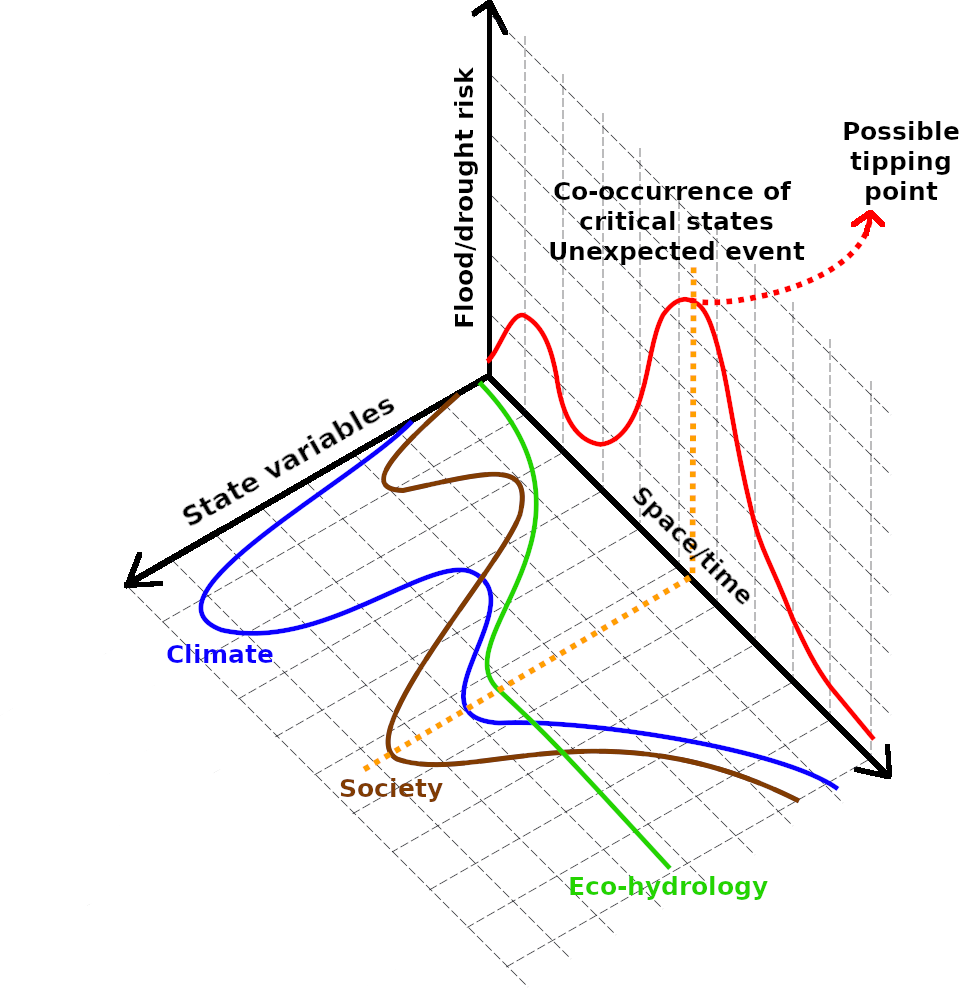
Stochastic amplification of climate change into floods and droughts change
Call for a global database of events of climate impact amplification |
Summary
Major floods and droughts occurring with increasing frequency have raised the concern that changes in climate may lead to a disproportionate and unexpected increase in flood and drought risk. Such amplification has the potential of producing megafloods and megadroughts whose magnitude is underestimated by current Earth system models, so that communities are taken by surprise. The reasons for the amplifications are currently not understood.
CO22Water will explore why, where and when changes in climate may lead to unexpected increases in flood and drought risk. The underlying hypothesis is that the amplification is controlled by the co-occurrence of critical patterns and states of climate, water cycle, ecological and human dynamics, and that the local conditions play a key role. For example drought risk may be exacerbated by unsuitable crop choice and increased irrigation, and flood risk may be exacerbated by lack of preparedness of communities.
In order to test these hypotheses, unravel the causes of risk amplification and make local risk predictions through scenario analyses, CO22Water will develop a new stochastic framework. The latter will be based on the concept of process based stochastic modelling I recently introduced for tracing random trajectories of phenomena that are incompletely known. In this concept, the uncertainty of predictions is explained statistically by relating their probabilities to process based explanatory variables, taking advantage of new, spatially distributed data sets, and thus improving process understanding. The new framework will be tested on case studies in Europe and other continents.
CO22Water will provide innovative guidance for planning risk mitigation and adaptation to avoid that citizens and managers are taken by surprise.
Research question
- Why, where and when changes in climate may lead to unexpected increases in flood and drought risk?
What processes and factors lead to amplification of flood and drought risk?
What framework of flood and drought risk amplification can be proposed that captures the above process interactions and enables the prediction of amplified flood and drought risk?
Main assumption
Flood and drought risk amplification is controlled by the co-occurrence of critical patterns and states of climate, water cycle, ecological and human dynamics, and that the local conditions play a key role (see figures below).

|  Co-occurrence of critical states for the three systems. |
The team (provisional composition)
- Alberto Montanari, professor, (principal investigator);
- Elena Toth, professor, team member;
- Marco Di Tommaso, professor, team member;
- Antonio Navarra, professor, team member;
- Sofia Vrettou, PhD student, team member;
- Giuditta Smerilli, PhD student, team member;
- Serena Ceola, associate professor professor, adjunct team member;
- Yue Lai, PhD student, adjunct team member.
Financing
The project is financed by the Italian Science Fund within the programme "Advanced Grant". The grant amount is 1.383.631,00 €.
The news on the web site of the Ministry for University and Research (in Italian) describes the FIS programme, which finances fundamental research by adopting the model of the ERC. The web site als reports the list of the financed project. Here the list for the domain Physical Sciences and Engineering (PE).
The duration of the project is 5 years. Project start date is May 1st, 2024.
CO22Water presentation
At the link below a short presentation of CO22Water can be downloaded.
Data base of extreme amplification event
The first key actions of CO22Water is to put together a global database of floods and droughts events where the socio-economic impact was amplified and people were taken by surprise. Data collection will start soon with a formal invitation to the global research community.
Last revised on November 3, 2024
- 625 views
